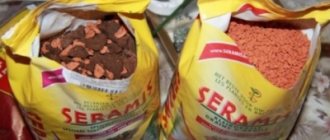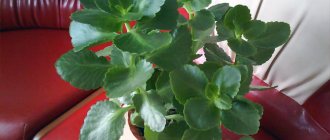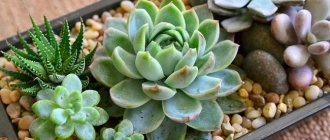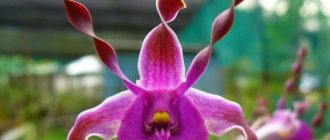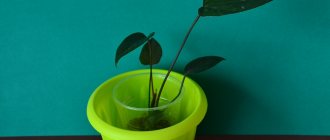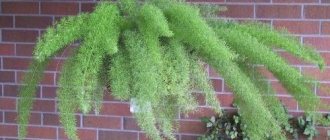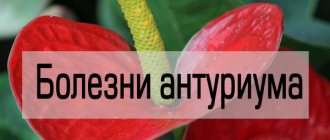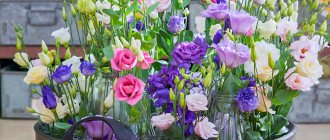What kind of soil care is needed at home?
In the natural environment, representatives of the species are able to grow in various soils, including clayey and sandy loam.
But decorative house plants are demanding on the composition and consistency of the soil. For indoor plants, it is necessary to ensure good breathability of the substrate, as well as porosity and drainage. The soil must retain moisture. Did you know? In the mid-20th century, anthurium became a commercial crop in the Hawaiian Islands. At that time, there were almost 300 farms that specialized in growing the plant. Since then, the demand for these beautiful flowers has continued and they are exported all over the world.
The soil must have the following properties:
- looseness;
- no caking;
- presence of air pockets;
- lack of compaction ability;
- weakly acidic reaction - pH 5.5–6.5.
Anthurium roots are similar to orchid roots, so their soil requirements are the same - sufficient moisture and access to oxygen.
The substrate must include three main components:
- land (turf);
- land (forest);
- sphagnum.
Otherwise, you can improvise by adding other components to the mixture:
- peat;
- earth (leaf);
- river sand;
- pine bark;
- small pebbles;
- expanded clay
The addition of mineral elements - vermiculite or perlite - is also useful. In the natural environment, anthuriums grow in the forest floor, tree bark, foliage layer and other forest debris. Therefore, when growing a flower at home, you need to try to imitate the same conditions.
If you don’t want to make the soil yourself, you can try buying it. Unfortunately, this can be difficult. Few manufacturers produce specialized soil for anthuriums.
- Substrate for anthuriums “Polessky”. Contains: high-moor and low-lying peat, bark, river sand, coconut fiber and chips, perlite, charcoal.
- Set of substrate components Aroid “Gardens of Aurica”. Contains: turf soil, bark and pine needles, sand, sphagnum.
- Substrate Anthurium "ForPro". Composition: high peat, bark, charcoal, agroperlite.
Some soils for orchids with a similar composition (based on peat and bark) are also good for anthuriums. For example, we read the composition of a set of substrate components for orchids from Aurika Gardens: peat, pine bark and needles, charcoal, vermicompost, sphagnum. Why not primer for anthurium?
The only thing that can be added to such a substrate is universal soil. To adjust the mixture towards the correct ratio of bark and peat soil (1:1).
Universal soil for flowers will not work. Due to lack of air, the roots will begin to rot, which will lead to the death of the plant. The flower needs the maximum imitation of its natural habitat.
Consequences of incorrectly selected soil:
- Drying of the plant, despite abundant watering.
- Stunted growth.
- Uneven development of leaves and stems.
- Withering and drying of leaves.
- Lack of flowering.
Below we consider in what soil it is best to replant a flower from a store, in what soil it will grow well. Making your own mixture is the best option. The soil for growing anthurium is prepared by combining several components. The main thing is to maintain proportions so that the soil is loose and moderately dense. Otherwise, a mixture that is too light will not be able to hold the plant, and a mixture that is too dense will suffocate the roots.
What components are used:
- Peat - regulates acidity and enriches the soil with nutrients.
- Sand - lightens the substrate and prevents root rotting.
- Charcoal - provides prevention of fungal infections.
- Turf - makes the mixture porous, which increases breathability.
- Needles - imparts looseness to the soil and protects against chlorosis.
- Leaf soil - increases the nutritional value of the substrate.
- Sphagnum moss regulates water and air exchange.
Peat is sold in garden stores, in packages of 1-2 kg or more. You can also buy sand there, or prepare it yourself. If possible, use river, coarse-grained.
Needles are collected from the forest. The needles need to be washed in a bright pink solution of potassium permanganate, then treated with foundationazole. It is better to purchase turf and leaf soil in the store.
Soil recipes:
- Deciduous and coniferous soil, peat, sand in the ratio 1:1:1:0.5.
- Turf, sand, leaf humus in the proportion - 1:1:2.
- Sod, sand, sphagnum, peat - 2:1:1:4.
- Conifer bark, moss, peat, turf - 1:1:1:2.
After planting the flower, a layer of sphagnum is placed on top of the prepared soil. It retains moisture and protects the roots from drying out.
What substrate should I use?
The thick, dense roots of anthurium resemble the roots of orchids. And their needs are similar. Such roots need a lot of air and moderate humidity. Accordingly, the soil for anthurium should be loose, contain a large number of air pockets, and not caking or compacting. And also, it allows water to pass through well and dry quickly. The required reaction is slightly acidic (pH 5.5-6.5).
Anthurium roots are similar to the roots of orchids and other epiphytes
By their nature, anthuriums are epiphytes and semi-epiphytes that practically do not need land. They grow in tropical forests under trees, with roots growing into the forest floor from bark, fallen leaves, and various debris. This is the kind of loose forest floor that the ideal soil for anthuriums should imitate.
Soil for anthurium is a mixture of peat soil with bark, sphagnum moss and various useful additives
Which substrate composition is best suited for planting a flower: preparation instructions
Below we consider in what soil it is best to replant a flower from a store, in what soil it will grow well. Making your own mixture is the best option. The soil for growing anthurium is prepared by combining several components. The main thing is to maintain proportions so that the soil is loose and moderately dense. Otherwise, a mixture that is too light will not be able to hold the plant, and a mixture that is too dense will suffocate the roots.
What components are used:
- Peat - regulates acidity and enriches the soil with nutrients.
- Sand - lightens the substrate and prevents root rotting.
- Charcoal - provides prevention of fungal infections.
- Turf - makes the mixture porous, which increases breathability.
- Needles - imparts looseness to the soil and protects against chlorosis.
- Leaf soil - increases the nutritional value of the substrate.
- Sphagnum moss regulates water and air exchange.
Peat is sold in garden stores, in packages of 1-2 kg or more. You can also buy sand there, or prepare it yourself. If possible, use river, coarse-grained.
Needles are collected from the forest. The needles need to be washed in a bright pink solution of potassium permanganate, then treated with foundationazole. It is better to purchase turf and leaf soil in the store.
You can prepare leaf humus yourself, but it will take 1.5-3 years. Foliage is collected from under fruit trees, put into bags and left on the site until it completely rots.
We invite you to watch a video on how to prepare soil for anthurium at home:
Soil recipes:
- Deciduous and coniferous soil, peat, sand in the ratio 1:1:1:0.5.
- Turf, sand, leaf humus in the proportion - 1:1:2.
- Sod, sand, sphagnum, peat - 2:1:1:4.
- Conifer bark, moss, peat, turf - 1:1:1:2.
After planting the flower, a layer of sphagnum is placed on top of the prepared soil. It retains moisture and protects the roots from drying out.
Ready-made mixtures for replanting
The easiest way to purchase a mixture suitable for planting is to buy it at a specialty store. Unfortunately, there are not many manufacturers of soil specifically for these indoor plants on the market. The most common of them are the substrate “Polessky”, “ForPro”, “Aurica Gardens”. These mixtures include all the components that are necessary for the effective growth and flowering of indoor epiphytes and semi-epiphytes.
They buy soil for orchids if they couldn’t find a ready-made mixture, and the time to replant the anthurium has already come. Orchids are also tropical plants and require an identical substrate based on peat and bark. You will have to add a little universal soil to this mixture to dilute these substances in a 1:1 ratio. If for some reason you have problems purchasing soil for orchids, you can plant anthurium in a substrate for begonias. This mixture needs to be replenished with the addition of perlite and sphagnum moss. Prepare the soil yourself if you need to guarantee the quality of the substrate for replanting your exotic pet.
Self-preparation of a mixture for replanting anthurium:
- The first method is quite simple. Add coniferous tree bark in a 1:1 ratio to the universal soil, which most often consists of a peat base, and then improve the quality of the substrate by adding one or more nutritional components to the soil.
- The second method of preparing soil for replanting is as follows: you need to mix coniferous tree bark, peat and moss in equal proportions. Peat should be coarse fibrous. Turf soil is added last, after thoroughly mixing the remaining components. Its amount should be twice that of the previous additives (1:1:1:2). Add a small amount of charcoal and boldly plant tropical anthurium in the ground.
Description of indoor plant
Anthurium belongs to herbaceous perennial plants of the aroid family. This delicate tropical flower has another name - flamingo. The leaves of the plant are dense, covered with a matte film, up to 20 cm long. The inflorescence is a spadix, around which there is a colored bract. It is rolled up into a tube so that the cob is clearly visible. Natural varieties have crimson bracts. Modern varieties and hybrids have a variety of colors, from blue to red, and there are varieties with a speckled cover. The flowers are fragrant.
After the flower fades, the perianth turns green and becomes a leaf. The flowers are small, with a complex pollination system. In their place, round-shaped fruits are formed. The seeds ripen up to one and a half to two months. They need to be sown immediately after harvest. Anthurium can be propagated by seeds after artificial pollination or vegetatively, by dividing the bush or by cuttings. The second method is much easier and more productive. Anthurium has about 100 beautifully flowering hybrids. If they are propagated by seeds, the properties of the mother variety are most often not transferred.
Despite the fact that there are about 500 species and varieties of this plant, the following are grown indoors:
- Anthurium Andre with red flowers of all shades or white. Andre Dakota is the most popular variety.
- Anthurium scherzerianum (Scherzer) up to 25 cm high and up to 40 cm wide. The leaves are arrow-shaped, the flowers are red, less often white or spotted. After flowering begins, they appear continuously and bloom several at a time. Flowering continues even in winter, but in summer the number of flowers is greater.
- Anthurium andreanum requires higher temperatures to grow, so it is not often found in apartments. The flowers are very large and stand cut for several weeks.
- Anthurium crystallinum is also picky about temperature and humidity. Valued for its beautiful velvety leaves with silver veins. The leaf shape is heart-shaped.
Disinfecting the soil before planting anthurium
It is recommended to disinfect both purchased soil and prepared soil yourself.
Disinfection of the soil helps to destroy possible infection and fungus that can harm the flower.
For disinfection, thermal and chemical methods are used:
- The finished soil is placed on a baking sheet and placed in the oven for 1 hour at a temperature of 80 to 100 degrees.
- Low temperature treatment. You can put the soil in the freezer or take it outside in winter if it is -7 or colder there. Keep the soil in the cold for at least 5 days.
- Steam disinfection. The soil is poured into a container, which is placed in a steam bath. Leave for 1.5 hours.
The method of freezing the earth is used quite rarely, as it has some disadvantages. Firstly, it is not very convenient to use, and secondly, it is not suitable for those mixtures in which vermicompost is present. Another significant drawback of freezing is that it does not rid the soil of the causative agent of a disease such as late blight.
The method of cultivating the soil in the oven also has its pitfalls. Not all pathogens are killed by high temperatures. Before placing the soil on a baking sheet, it is recommended to first pour boiling water over it and mix thoroughly.
Chemical treatment methods include the use of fungicides. Recommended drugs:
- "Fitosporin";
- "Glyocladin";
- "Extrasol";
- "Barrier".
They are used according to the instructions.
The method of treating the soil with a solution of potassium permanganate has proven itself well. For 10 liters of water there are from 3 to 5 crystals. Watering the land is carried out at a dosage of 1 square. meter from 30 to 50 ml.
Additional Information! The soil is disinfected 14 days before its use.
Soil requirements for spathiphyllum
Before selecting soil for a plant, you need to find out in what conditions it grows in nature. The homeland of spathiphyllum is the humid subtropics. It grows mainly along rivers, lakes or in wetlands. In such places, the soil is usually rich in humus and peat.
What should be the soil for spathiphyllum:
- loose;
- breathable;
- moisture permeable;
- light;
- fertile;
- slightly acidic.
Soil acidity should be within 5.5. If the acidity level is high, then dolomite flour, slaked lime or wood ash can be used to reduce it.
Note! To increase breathability, river sand is added to the substrate. Good drainage is also required - pebbles or expanded clay.
What soil composition is necessary for a flower of female happiness
Before buying soil, you need to carefully study the composition. But before that, you need to figure out which ingredients must be included in the soil mixture, and which should not be there. For successful cultivation, you need to know in advance what kind of soil spathiphyllum likes.
What soil is suitable for spathiphyllum and what should be included:
- sand, agroperlite or vermiculite;
- deciduous or turf land;
- peat;
- humus;
- superphosphate;
- charcoal.
The base is deciduous or turf soil. There should be more of it in the composition. Peat and humus are added in equal quantities. Ingredients such as sand, agroperlite and charcoal should occupy no more than 10% of the total mass of the substrate.
Advice! You can use ground bricks and small pieces of tree bark as a leavening agent.
Should the land for planting and replanting be different?
The soil for spathiphyllum, as well as for the closest relative of this flower, Anthurium, during planting and replanting may be the same in composition. It is not necessary to change the composition of the soil with each transplant. You can even leave the old drainage layer, just rinse it thoroughly before replanting the flower.
In summer, you can transplant the flower outside into open ground. It is planted together with the substrate in which it grew in a pot at home.
How to determine that the soil needs to be changed?
Alarm signals are easily identified by their appearance:
- Root shoots grow through drainage holes at the bottom of the pot.
- Pests (mites, aphids, cobwebs) were found on the surface of the top layer of soil and on the plant itself.
- When leaves, roots, and stems are infected with infections of rot, fungus, and spotting, the soil is partially or completely changed.
- The flower itself is cut off, replanted, and sent to quarantine.
What soil is suitable for “male happiness”
Soil for spathiphyllum - what kind of soil is needed for a flower
Earth for anthurium needs a certain composition, each element of which has its own purpose:
- Peat provides the soil with the necessary level of acidity. Thanks to peat, the soil becomes loose and airy. This element is a source of nutrients and minerals.
- Sphagnum moss allows water to pass through and gives lightness to the soil. It is needed in order to maintain a certain level of humidity near the root system of the plant, preventing drying out. Moss promotes better and faster survival of young flowers and reduces stress for the plant after transplantation. It is placed last in the pot, on the soil. It is recommended to always keep moss slightly moist.
- Sand is responsible for the lightness of the soil. The presence of sand in the substrate prevents caking of the soil and stagnation of moisture.
The correct mixture of all components and their dosage provides the flower with a nutritious basis for growth and flowering
- Rotted needles are the most valuable element for soil with low acidity levels. The needles make the soil loose and light and maintain the pH value. It has a bactericidal effect, reducing the likelihood of infections.
- Turf is an organic ingredient that makes the substrate porous.
- Charcoal increases the substrate's resistance to bacteria and fungi. It is also used as drainage. And the presence of charcoal in the soil prevents infections and fungi.
- Leaf soil makes the soil loose and light. The presence of rotted and rotten leaves ensures a slightly acidic pH level.
- Compost is decomposed organic matter that nourishes the earth and saturates it with macro and microelements.
Attention! Compost itself is a rather aggressive organic component, so it is used in small quantities. A high content of compost in the substrate can lead to burning of the roots and death of the plant.
The soil for “male happiness” is usually enriched with a large amount of nutrients and mineral elements. What kind of soil is suitable for transplanting anthurium - made independently or purchased - each gardener decides for himself. When replanting, the transfer method is used: the flower is carefully removed from the old container, and a lump of the same soil is left around the roots. It is placed in a new pot. The voids are filled with earth.
Soil disinfection
When replanting a flower, it is very important to carry out preventive treatment of the soil, because plants planted in self-prepared mixtures are threatened not only by fungi and bacteria, but also by the presence of pest eggs. There are several ways to disinfect the substrate:
There are several ways to disinfect the substrate:
- "Frost treatment" In winter, the substrate is taken out into the frosty air and left for 4-5 days. The air temperature should not be higher than – 5 – 7°C. Over this period of time, pathogenic organisms existing in the soil will die.
- Heat treatment. The soil is disinfected under high temperature. The processing rules are as follows: the soil is kept in an oven preheated to 80°C for an hour to provide reliable protection against the development of harmful microorganisms.
- Steam treatment. Another reliable way to neutralize soil is to treat it with steam. To do this, wrap the soil in a cloth and place it on a wire rack over a steam bath. This procedure must be carried out for at least an hour and a half.
- Treatment with a disinfectant mixture. For such treatment, you can use fungicides, or you can prepare your own disinfectant solution. To prepare it, dissolve 3 grams of potassium permanganate (potassium permanganate) in 5 liters of boiling water and treat the ground. It is recommended to use industrial biological mixtures - “Agat” or “Integral”. They include beneficial bacteria that destroy pathogenic microorganisms. The method of their use is indicated on the packaging.
It is important to know that substrate components such as peat and moss create favorable conditions for healthy soil flora and should not be processed. It is necessary to mix all parts of the soil after the treated components have cooled.
Pros and cons of purchased soil and prepared soil yourself
Soil for gloxinia - what kind of soil is suitable for a flower
Each gardener chooses which soil to plant anthurium in, ready-made or prepared independently. Homemade and purchased soil have their advantages and disadvantages.
Ready substrate
| Advantages | Flaws |
| Compliance with all rules for preparing the substrate. There is no need to further cultivate and prepare the land. | The exact amount of mineral elements is unknown. The manufacturer indicates only approximately (from 4 to 6/100g) |
| Saturation with all macro and microelements and nutrients. | The pH level is approximate, from 4.5 to 6. The soil may be slightly acidic or neutral. |
| Balance of all ingredients. | To make the mixture cheaper, peat can be replaced with peat dust. |
| The soil is always light, moisture-permeable and loose. | Risks of purchasing low-quality soil, contaminated or with non-standardized elements. |
| Possibility to choose the exact amount of land - from 1 to 50 liters. |
Purchased soils should be selected only of high quality
Do-it-yourself soil for a flower has the following advantages:
- using the same substrate when planting and replanting anthurium reduces the level of stress and promotes rapid acclimatization of the plant;
- the ability to accurately dose all elements according to the soil preparation recipe;
- confidence in a sufficient amount of macro and microelements;
- saving.
Disadvantages of using a homemade soil mixture:
- additional time spent collecting all the ingredients and preparing the soil, since not all components can be found on the site;
- the likelihood of contamination of ingredients by fungus or infection;
- additional expenses for purchasing ingredients.
Note! When deciding what kind of soil is needed for anthurium when replanting - purchased or prepared independently, it is recommended to choose the one that was originally used.
What kind of drainage is needed for growing?
The health and beauty of anthurium depends on the presence of drainage, because these plants do not tolerate stagnation of water in the root system and may die. To create optimal conditions for flower growth, you need to think about good drainage, only in this case excess water will drain away and the roots will breathe.
The following materials are suitable for preparing drainage:
- clay shards;
- broken brick;
- expanded clay;
- gravel;
- crushed stone;
- Styrofoam.
The most popular material for drainage is expanded clay; it is able to absorb excess moisture. These are baked pieces of clay that have a porous structure. You can buy it at flower shops.
When using other materials as drainage, you must follow the following tips:
Drainage and sphagnum moss
A properly selected substrate is not everything.
To prevent irrigation water from stagnating in the pot and causing the roots to rot, a layer of drainage - expanded clay - is poured onto the bottom of the pot. Preferably a large fraction to form air pockets. Anthurium roots love to breathe! In addition, expanded clay acidifies the soil, making it more suitable for anthurium.
After planting, a small layer of sphagnum moss is laid on the surface of the soil to cover the aerial roots. You should try to keep the moss moist by spraying it regularly.
Sphagnum moss is used to maintain moisture in anthurium aerial roots.
It is worth noting that the correct choice of soil for anthurium will protect your flower from many problems, such as: rotting of the roots due to stagnation of water and lack of air, lack of flowering, stunted growth.
Does anthurium need drainage?
Often gardeners have a question: “Do anthuriums planted in a mixture of bark and peat need drainage?” The answer is clear: drainage is vital, because stagnation of water in a flowerpot is destructive for them. Drainage can be made from expanded clay, brick, large pieces of bark and even foam. The drainage pockets should be large enough, so use large pieces of your chosen material. Be sure to disinfect the material for making drainage, after scalding it several times with boiling water.
There is no need to replant anthurium often, but a serious approach to this issue is required. If you follow all the recommendations and choose the right soil, the tropical guest will thank you not only with lush color, but also cleanse the air of your home from such harmful impurities as xylene, ammonia and formaldehyde.
Care Tips
Very often, anthuriums wither away from strong care and unnecessary care. With these plants, everything should be in moderation. Do not neglect fertilizers, flood the flower, or block access to sunlight.
- The plant is replanted not only after acquisition, but also every 2 years thereafter. This is due to its rapid growth. If the anthurium roots do not have enough space, the flower withers and quickly fades. When replanting, be sure to grab a lump of old substrate to make it easier for the plant to take root in a new place.
- In winter, anthurium enters a dormant period. The room temperature is reduced to +18. If the flower is cold, this manifests itself in the formation of brown spots on the leaves. Then you should increase the temperature by a few degrees. In this case, the plant should have enough light. If necessary, additional illumination is carried out.
- Watering should be regular but moderate. The plant does not tolerate excess moisture. The pan is drained after each watering to avoid root rotting. Only settled (softened) water is suitable. From hard water, the plant will begin to hurt, become covered with heels and gradually die. It would be a good idea to spray several times a day (in winter – once every 7 days).
What if the plant does not take root or withers after transplantation?
- If the leaves of an anthurium turn yellow, then most likely the root system was damaged during transplantation. This is the most vulnerable spot of this plant. If the damage was minor, then you should just wait and let the flower survive the stress.
- Leaves may also turn yellow due to differences in soil composition and air permeability if the entire earthen ball is replanted. Only a complete replacement of the soil will help here.
- If the flower fades quickly, then you may have missed pests on the roots. The plant can be saved only by replanting with a complete replacement of the soil and treating the roots with manganese. If the wilting is not particularly active, wait. Perhaps the anthurium simply has not yet had time to get used to the new conditions and it makes sense to wait for the root system to work at full capacity.
- Wilting can be caused by the wrong choice of location after transplantation. Do not forget that the plant has experienced stress. Do not place it in the sun or leave it completely without light.
- Lack of growth in the first few months should not be a cause for concern. The plant simply takes over the space of the pot with its roots. If it hasn’t been growing for a long time, then perhaps the pot was very large and all the effort goes into building up the underground part.
- The flower dries out if the watering regime and air humidity are not observed. You should study in more detail the issue of creating a comfortable environment for this plant.
Read more about problems after anthurium transplantation here.
In order for the beautiful anthurium to delight you with flowering for a long time even after transplantation, it is important to follow all the stages of updating the root habitat and not neglect the importance of enhanced care during the period of anthurium’s adaptation to a new place
